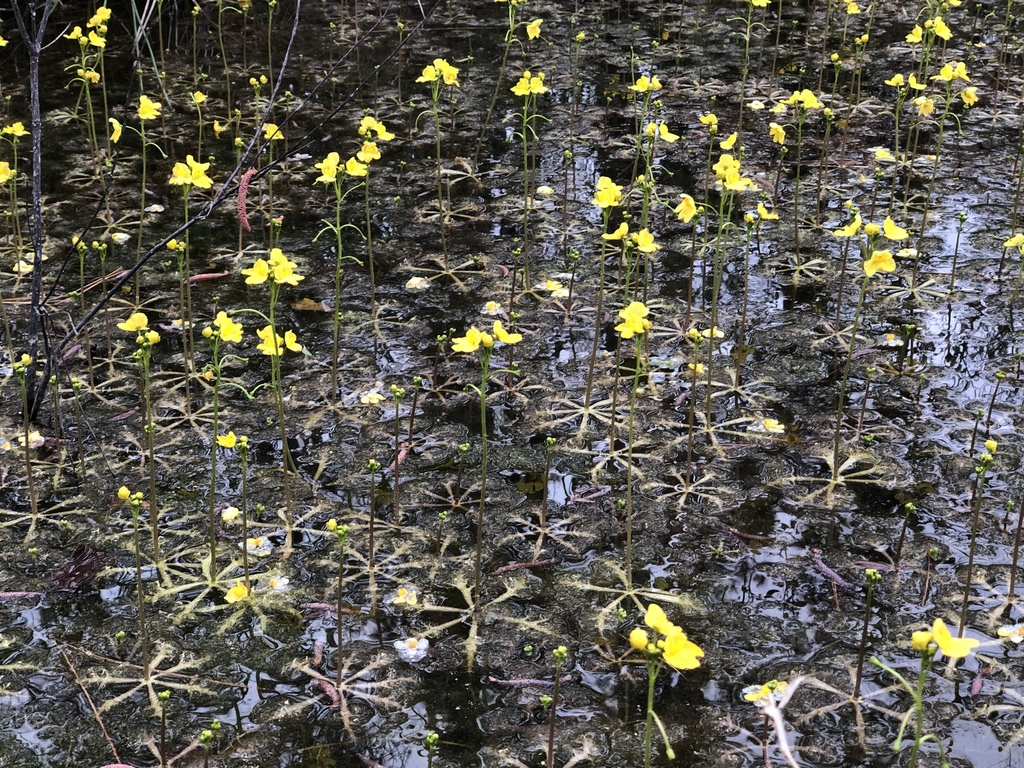Freedom—October 18, 2023—It’s a pretty plant with a curious name and the potential to create problems. DES says it’s not overly worried at the moment, but it’s on their radar.
By next summer it could be on our radar as well, as it has made its way into Pine River and likely will be flushed into the lake with the spring melt.
It’s called Utricularia inflata, or swollen bladderwort. It’s a bushy, rootless, carnivorous aquatic plant native to the southern coastal plains of the U.S.
In early spring, 3-15 yellow snap dragon-shaped flowers develop on emergent stalks. The stalks are supported by a floating pontoon comprised of 4-10 leaves arranged like the spokes of a wheel. The pontoon leaves are 1.5” long and appear inflated.
Organisms are lured to the bladders with a sweet scent, and when trigger hairs on the bladder are brushed, the trap door opens and a vacuum force pulls the prey—zooplankton, water fleas, aquatic worms and mosquito larvae—inside to be digested.

Swollen bladderwort can form dense mats that crowd out native aquatic plants.
Its carnivorous characteristic gives it an advantage over native plants, which it can crowd-out as it spreads on the water in large mats.
It primarily reproduces by fragmentation, so a small piece attached to a boat or fishing gear can help spread it. Once established, it’s difficult to remove manually, and doing so incorrectly can spread it further.
Its reproduction characteristics mimic invasive variable water-milfoil, which has bedeviled the lake since the 1980s, and is a statewide problem requiring expensive professional harvesting and chemical control treatments.
Also like invasive variable water-milfoil, swollen bladderwort has a native, non-threatening cousin. The relative is called Utricularia radiata, or floating bladderwort.
Local weed watchers will need to learn the difference, but specialists will still likely be needed to make the final call on whether a reported bladderwort is the good weed or the bad one.
Pine River Pond Report
The appearance of swollen bladderwort in Pine River was reported to Green Mountain Conservation Group this summer by Patty Philbrook, president of Pine River Pond Association, who said weeds had proliferated due to nutrients washed into the water by heavy rains.
Philbrook said it appeared that the bladderwort picked up a lot of other plants as it made its way toward the dam at the end of the pond, creating weed bundles as long as 100 ft. She estimated 90 percent of the bundles were native—a bit of good news.
On the other hand, the invasive version made it over the dam. When the Dam Bureau removes the boards of the dam for winter drawdown, more bladderwort will likely enter the river and head toward the big lake, potentially depositing large bundles of weeds along the way.
Effingham’s Conservation Commission has the invasive on its watch list. Commission Chair Emelyn Albert created a fact sheet for the group, and checked for the weed in the town’s Cherubini Preserve, which abuts Pine River.
She didn’t find any in the preserve, but said she agrees that when the boards come out of the Pine River Pond dam for the winter, the invasive bladderwort is likely to migrate.
DES Exotic Species Program Coordinator Amy Smagula made a visual confirmation of the invasive with Barre Hellquist, the long-time Ossipee Lake resident whose “Aquatic and Wetland Plants of Northeastern North America” is considered the definitive work on the subject.
Smagula said she has also documented swollen bladderwort in Powwow Pond in Kingston and Back Bay in Wolfeboro.
Based on feedback from Hellquist, and the fact that most other states in the region are not yet managing swollen bladderwort, she said DES is not overly worried at the moment.
But she wants to know if people find it in the lake in the spring. Sightings can be reported by email to Amy.Smagula@des.nh.gov.

OssipeLake as a smaller species, Little floating bladderwort, Utricularia radiata, which looks like the larger Floating bladderwort, Utricularia inflata. Utricularia radiata is native to all the local lakes, while the U, inflata is a southern species that is moving north,